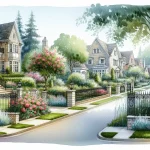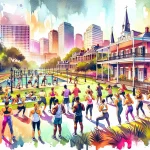New Orleans’ Lower Ninth Ward has embarked on a remarkable journey of resilience and revival following the catastrophic impact of Hurricane Katrina in 2005. This historically significant and culturally rich neighborhood, once a thriving community, faced immense challenges after the storm, but the unwavering spirit and determination of its residents have driven an extraordinary transformation.
In This Article
TL;DR
- The Lower Ninth Ward holds immense historical and cultural significance but was devastated by Hurricane Katrina.
- Current revitalization efforts, through government initiatives, non-profit organizations, and community engagement, are breathing new life into the neighborhood.
- Notable figures and organizations like Brad Pitt’s Make It Right Foundation and the Lower Ninth Ward Living Museum are spearheading rebuilding efforts and preserving the area’s legacy.
Historical Context of the Lower Ninth Ward
Prior to Hurricane Katrina, the Lower Ninth Ward was a vibrant and close-knit community, predominantly populated by African Americans. It boasted one of the highest rates of Black homeownership in the United States, a testament to the neighborhood’s resilience and pride. The area’s rich cultural heritage was deeply rooted in its music, art, and traditions, contributing to the unique character of New Orleans.
However, on August 29, 2005, Hurricane Katrina unleashed its fury, breaching the Industrial Canal levee and submerging the Lower Ninth Ward under a deluge of water. The catastrophic flooding left homes and businesses destroyed, displacing thousands of residents and shattering the fabric of the community. Initial recovery efforts were slow and arduous, as residents faced immense challenges in rebuilding their lives and homes.
Current Revitalization Efforts
In the years following Katrina, a multitude of initiatives have been undertaken to revitalize the Lower Ninth Ward. The government, through programs like the Road Home and the Hazard Mitigation Grant Program, has provided funding and resources to assist homeowners in rebuilding their properties. Additionally, non-profit organizations like the Make It Right Foundation, founded by actor Brad Pitt, have played a pivotal role in constructing sustainable and affordable housing for returning residents.
One of the most significant projects is the development of the Lower Ninth Ward Living Museum, which aims to preserve and celebrate the neighborhood’s rich cultural heritage. The museum offers educational programs, tours, and exhibits that showcase the area’s history, traditions, and resilience.
Community Engagement and Response
The revitalization efforts in the Lower Ninth Ward have been driven by the active involvement of local residents. Community meetings and forums have allowed residents to voice their concerns, share their visions, and contribute to the planning and execution of projects. Organizations like the Lower Ninth Ward Neighborhood Council and the Lowernine.org have been instrumental in facilitating this community engagement.
Residents have expressed a mix of hope and skepticism regarding the revitalization efforts. While many are grateful for the progress made, concerns remain about gentrification, affordability, and the preservation of the neighborhood’s cultural identity. Success stories of individuals and families who have returned and rebuilt their homes serve as inspiration for others to follow suit.
Economic Impact of Revitalization
The revitalization of the Lower Ninth Ward has brought about significant economic opportunities and growth. New businesses, ranging from restaurants to retail stores, have opened their doors, providing employment opportunities and contributing to the area’s economic revival. Additionally, the influx of construction projects and infrastructure improvements has created jobs and attracted investment from both public and private sectors.
Long-term economic forecasts for the Lower Ninth Ward are promising, with projections indicating continued growth and development. However, ensuring equitable access to these opportunities and preventing displacement of long-time residents remains a priority for community leaders and policymakers.
Cultural Preservation and Innovation
Amidst the revitalization efforts, preserving the cultural heritage of the Lower Ninth Ward has been a central focus. Organizations like the Backyard Cultural Museum and the Treme Center for the Arts have played a crucial role in celebrating and promoting the area’s rich traditions, including music, art, and storytelling.
At the same time, new cultural initiatives and community programs have emerged, fostering creativity and innovation. Local artists and musicians have found platforms to showcase their talents, while youth programs aim to nurture the next generation of cultural ambassadors for the Lower Ninth Ward.
Environmental Considerations and Sustainability
In the wake of Hurricane Katrina’s devastating impact, environmental sustainability and flood prevention measures have become paramount in the revitalization efforts. Green building practices, such as the use of renewable energy sources and energy-efficient materials, have been incorporated into new construction projects. Additionally, efforts have been made to restore and protect local ecosystems, ensuring the long-term resilience of the community.
Community education and involvement in environmental sustainability initiatives have been crucial in fostering a sense of responsibility and stewardship among residents. Programs like the Lower Ninth Ward Environmental Corps have empowered youth to take an active role in preserving their neighborhood’s natural resources.
Challenges and Criticisms
Despite the progress made, the revitalization of the Lower Ninth Ward has faced ongoing challenges and criticisms. Funding shortfalls, bureaucratic hurdles, and the slow pace of recovery have been sources of frustration for many residents. Additionally, concerns have been raised about the potential loss of the neighborhood’s cultural identity and the displacement of long-time residents due to rising property values and gentrification.
Critics have also questioned the sustainability and long-term viability of some revitalization efforts, citing the need for more comprehensive planning and community involvement. Addressing these challenges and incorporating feedback from residents will be crucial in shaping the future of the Lower Ninth Ward.
Future Outlook and Potential Developments
As the revitalization efforts continue, the Lower Ninth Ward is poised for further growth and development. Potential projects include the expansion of affordable housing initiatives, the establishment of new community centers and recreational facilities, and the enhancement of public transportation options.
However, the future of the Lower Ninth Ward will also be influenced by external factors, such as government policies, economic trends, and environmental considerations. Ongoing collaboration between residents, community leaders, and stakeholders will be essential in navigating these challenges and seizing opportunities for sustainable and equitable development.
The revitalization of the Lower Ninth Ward is a testament to the resilience and determination of its residents and the broader New Orleans community. While challenges remain, the progress made thus far serves as a beacon of hope, demonstrating the power of collective action and the enduring spirit of a neighborhood that refuses to be defined by adversity.






